Our Solar System - 1 | Geography for UPSC CSE PDF Download
| Table of contents |

|
| Evolution Theory of The Solar System |

|
| Cataclysmic or Catastrophic Theories |

|
| Grouping of Planets |

|
| Mains Questions |

|
The congregation of stars and planets is known as the solar system. It is a group of planets, meteors, or other objects that orbit a large star. Our solar system having a disc-like shape includes everything that is gravitationally drawn into the sun's orbit and consists of 8 planets (e.g. Mercury, Venus, Earth, Mars, Jupiter, Saturn, Uranus, and Neptune) and one star (the Sun), 63 moons, millions of smaller bodies like asteroids and comets and a huge quantity of dust-grains and gases.
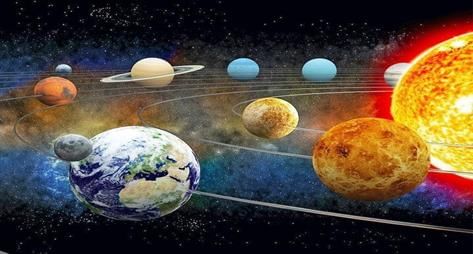 The Solar System
The Solar System
Pluto was previously considered as the 9th planet of the Solar System but the International Astronomical Union (IAU) demoted Pluto and recognized it as a “dwarf planet” in 2006.
Planets are non-luminous bodies whereas stars are luminous bodies of the universe. The Nebula from which our Solar system is supposed to have been formed started its collapse and core formation about 5-5.6 billion years ago and the planets were formed about 4.6 billion years ago.
A nebula is an interstellar cloud of dust, hydrogen, helium, and other gases. Nebulae are often star-forming regions, where gas, dust 'clump' together to form larger masses, which eventually become massive enough to form stars.
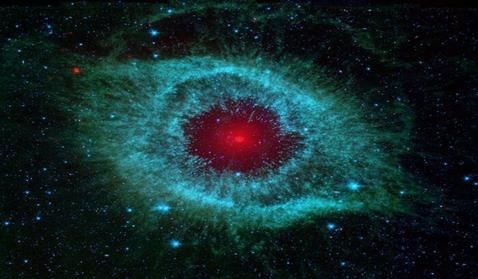 Nebula
Nebula
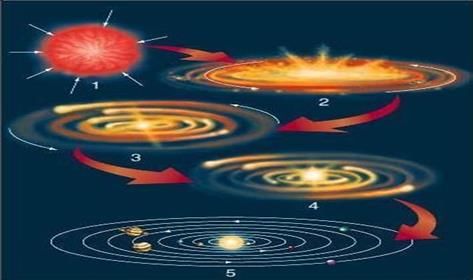 Formation of the Solar System
Formation of the Solar System
Our Solar System is a small part of the system of stars collectively known as the galaxy. Astronomers have discovered there are many other large stars within our galaxy, the Milky Way.
Milky Way Galaxy: This galaxy is where our solar system is located. It has a disk, a central bulge, and spiral arms. The disk is about 100,000 light-years across and 3,000 light-years thick. Most of the Galaxy's gas, dust, young stars, and open clusters are in the disk.
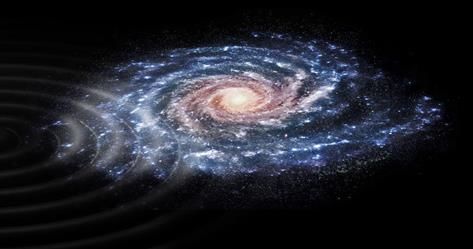 Milky Way Galaxy
Milky Way Galaxy
Evolution Theory of The Solar System
➤ Gaseous Hypothesis of Immanuel Kant
- According to him, the hard particles were supernaturally formed and then collided with one another.
- Further, he assumed that the collisions between particles took place because of the mutual gravitational attraction.
- Due to this process, the heat was generated and the original static and cold matter was converted into a rotating nebula which was characterized by a strong centrifugal force about its equatorial plane.
- Following this, the successive rings of matter were thrown off, which in course of time condensed to form the planets.
- The planets underwent similar spinning and throwing the matter away in the form of rings then to form the satellites.
 Kant’s Gaseous Hypothesis
Kant’s Gaseous Hypothesis
Evaluation: It is criticized because Kant did not explain the source of the origin of the primordial matter. He also did not explain the source of energy that caused the random motion of cold matter, which was motionless in the initial stage. The collision among the particles of the primordial matter can never generate rotatory motion in it. So, it is an erroneous statement of mechanism. Kant’s assumption was against the law of conservation of angular momentum that the rotatory speed of the nebula increased with the increase of its size.
- It is the modified version of Kant’s hypothesis.
- With gradual cooling, the nebula shrank and started spinning even more rapidly. The spinning motion caused the nebula to flatten to a disk-like shape.
- Eventually, the centrifugal force around the margin of the disc became sufficient to cause a ring of material to separate and be left behind as the rest of the nebula continued to contract.
- Subsequently, as the shrinking parent disk continued to spin faster, smaller rings separated.
- In the next stage, condensation of matter started and particles collected in larger aggregates. The aggregates eventually collided and collected in the form of planets and satellites.
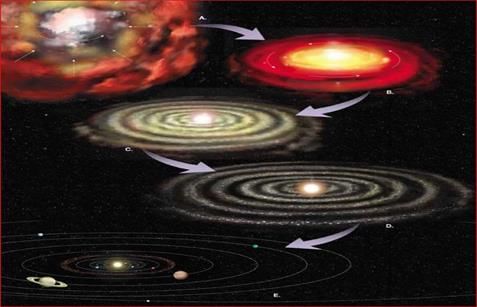 Laplace’s Nebular Hypothesis
Laplace’s Nebular Hypothesis
- Evaluation: Laplace did not describe the source of the origin of the nebula. He could not explain the formation of a fixed number of planets. He also said that the planets were formed from the nebula, and then the planets must have been in a liquid state in their initial stage. But the planets in liquid state cannot rotate and revolve around the Sun properly because the rotatory motion of different layers of the liquid is not always equal. According to this hypothesis, all the satellites should revolve in the direction of their planets but contrary to this a few satellites of Saturn and Jupiter revolve in the opposite direction.
Cataclysmic or Catastrophic Theories
- According to this, the solar system was formed from the Sun (big incandescent gaseous mass of matter and stationary) and another intruding star (bigger in size than the primitive sun).
- There was a great impact of the tidal force of the intruding star on the surface of the primitive sun. When the ‘intruding star’ came nearest to the ‘primitive sun’ its gravitational force became maximum, resulting in a giant cigar-shaped mass called a filament- thick in the center and thin and sharp at the ends.
- The nine planets of our solar system were formed due to cooling, condensation, and breaking of the incandescent mass of gaseous matter of the filament.
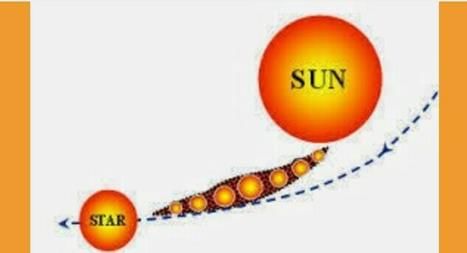 Cigar Shaped Filament
Cigar Shaped Filament
- Modification by Jeffreys: He presented his concept of ‘collision hypotheses’.
- There were three stars in the Universe before the origin of the solar system. primitive sun, the ‘companion star’ and the ‘intruding star’ which was moving towards ‘companion star’.
- Thus, the intruding star collided against the ‘companion star’. Due to a head-on collision, the companion star was completely smashed and shattered, some shattered portions were scattered in the sky while remaining debris started revolving around the primitive sun.
- The planets of our solar system were formed from the remaining debris of the companion star.
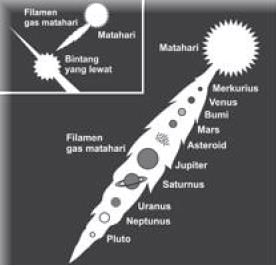 Planets Formed in The Cigar
Planets Formed in The Cigar
➤ Evaluation
- The whereabouts and the density of the intruding star were not explained.
- The real distances between the sun and the planets in our present solar system were unexplained.
- Also, Jeans could not elaborate on the process and mechanism of the condensation of matter ejected from the primitive sun.
➤ Nova star hypothesis of Hoyle and Lyttleton
- According to this, initially, there were two stars in the universe viz.(i) the primitive sun and (ii) the companion star (giant size and later on became supernova due to nuclear reaction).
- The companion star was consumed and it collapsed and violently exploded due to the nuclear fusion process (the atoms of lighter elements combine under intense heat and pressure to form atoms of heavier elements, releasing vast amounts of energy).
- The gaseous matter that came out due to the violent explosion of the companion supernova star changed into a circular moving disc which started revolving around the sun (building material for the formation of future planets).
- Thus, the planets of our solar system were formed due to condensation of the matter thrown out of the supernova due to its violent explosion.
 Supernova Hypotheses
Supernova Hypotheses
➤ Evaluation
- It attempts to solve the problem of angular momentum of the planets, the problem of the great distance between the planets and the Sun, and the problem of heavier elements of the material of the planets than the sun.
- But it fails to explain the peculiar arrangement of the planets on the basis of their size, similar direction of rotation as well as the plane of revolution of the planets of the outer circle of our solar system.
➤ Interstellar dust hypothesis of Otto Schmidt:
- Scientific researches about the universe have given ample evidence of the presence of ‘dark matter’ in the form of gas and dust particles known as ‘gas and dust clouds’ in the universe.
- Though he explained the mode of origin of this dark matter (gaseous cloud and dust particles), it may be safely assumed that these gaseous clouds and dust particles might have been formed from the matter coming out of the stars and meteors.
- The dark matter after being attracted by the sun during its ‘galactic revolution’ started revolving around the primitive rotating sun. These dark matters were called ‘interstellar dust’ by Schmidt.
Thus, the dust particles after being combined and condensed and were changed into a flat disc of captured dark matter started revolving around the sun and under the combined impacts of three types of:
(i) Gravitational force (exerted by the sun on the disc of dark matter)
(ii) The rotational motion (of the sun itself) and
(iii) The angular momentum (of dark matter of the disc).
- Every particle of dark matter in the universe started redistributing itself on the basis of mass, density dimension, and the existing amount of centrifugal force tending to push the particles away from the sun and the centripetal force tending to push the particles towards the sun.
- Collision among the dust particles started the process of aggregation and accretion around the bigger particles which became the embryos of the future planets.
- With the passage of time, these embryos captured more and more matter and thus grew in size to become asteroids which in turn grew in size due to continuous accretion of nearby matter around them and thus they became planets.
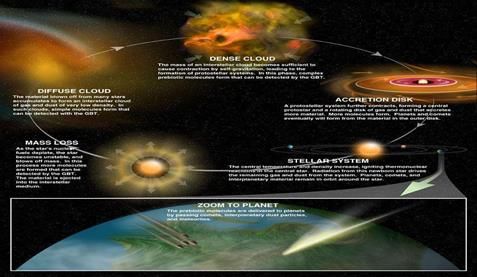 Interstellar Dust Hypothesis
Interstellar Dust Hypothesis
- Evaluation: This hypothesis solves almost all of the problems of the peculiar characteristic features of the solar system like:
(i) Near circular and similar planes of orbits of the planets
(ii) Revolution in the equatorial plane of the sun closely matching with the orbital planes of the planets.
(iii) Placement of planets according to their size on the basis of well-founded laws and
(iv) High-density planets in the outer circle of the solar system and
(v) Large and peculiar distribution of angular momentum among the planets of the solar system.
➤ Big Bang theory
- The Big Bang theory was postulated in the 1950s and 1960s.
- It was validated in 1972 through considerable evidence received from COBE (Cosmic Back-ground Explorer) which explains the origin of the universe and everything in it.
- According to this theory, everything in the universe developed from a point known as the singularity, 15 billion years ago at an affixed moment in time. “As the universe expanded for 15 billion years, the hot radiation in the original fireball also expanded with it, and cooled as a result.”
- The galaxies moved apart from one another as the empty space between them expanded.
- In the beginning, the Universe was much smaller as there was less space between the galaxies.
- It may be summarised that there was a single fireball some 15 billion years ago. ‘There were already wispy clouds of matter stretching across vast distances, upwards 500 million light-years across.
- As those clouds collapsed in upon themselves, pulled together by their own gravity, they would have broken up and formed clusters of galaxies with the galaxies themselves breaking up into stars like those of the Milky Way’.
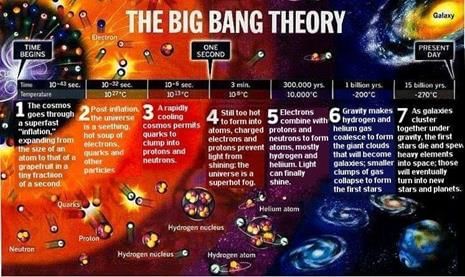 Big Bang Theory
Big Bang Theory
Grouping of Planets
Out of the eight planets, Mercury, Venus, Earth, and Mars are called “the inner planets” as they lie between the Sun and the belt of asteroids the other planets, Jupiter, Saturn, Uranus, and Neptune are called “the outer planets”. Alternatively, the first four are called Terrestrial, meaning earth-like as they are made up of rock and metals, and have relatively high densities. The rest are called Jovian or Gas Giant planets. Jovian means Jupiter-like. Most of them are much larger than the terrestrial planets and have a thick atmosphere, mostly of helium and hydrogen. All the planets were formed in the same period sometime about 4.6 billion years ago.
The difference between terrestrial and Jovian planets can be attributed to the following conditions:
- The terrestrial planets were formed in the close vicinity of the parent star where it was too warm for gases to condense to solid particles. Jovian planets were formed at quite a distant location.
- The solar wind was most intense near the Sun, which blew off lots of gas and dust from the terrestrial planets. The solar winds were not that intense to cause similar removal of gases from the Jovian planets.
- The terrestrial planets are smaller and their lower gravity could not hold the escaping gases.
- The rotatory motion of the planets (except Venus and Uranus) is in the same direction as their revolution around the sun.
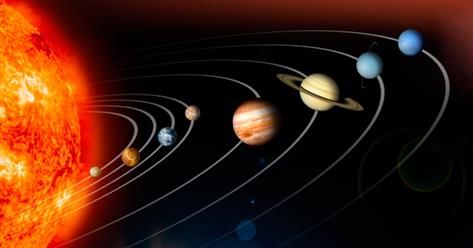 Arrangement of Planets in The Solar System
Arrangement of Planets in The Solar System
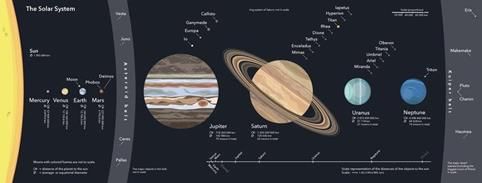 Grouping of Planets in The Solar System
Grouping of Planets in The Solar System
Mains Questions
1. What do you mean by ‘Big Bang’? How does it explain the formation of our Solar System? [250 words]
Approach-
Introduction: briefly explain what is meant by Big Bang Body: describe the big bang theory with respect to the origin of the universe and the solar system and evaluate its merits and demerits. Conclusion: End the answer by noting that the theory is the closest to reality but yet incomplete.
|
263 videos|875 docs|232 tests
|
FAQs on Our Solar System - 1 - Geography for UPSC CSE
| 1. What is the Evolution Theory of the Solar System? |  |
| 2. What are Cataclysmic or Catastrophic Theories about the Solar System? |  |
| 3. How are the planets grouped in our Solar System? |  |
| 4. What are some frequently asked questions related to the Evolution Theory of the Solar System? |  |
| 5. Are there any alternative theories to the Evolution Theory of the Solar System? |  |
















